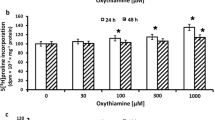Abstract
The effect in vitro of aluminum (Al) ions on DNA synthesis and human dermal fibroblast proliferation using [Al] concentrations from 1.85 to 74 µM and incubation periods of 1, 2, 3, 4, and 5 d was assessed. The lowest concentration of Al that exerted a slight positive, although not significant, effect on DNA synthesis was 1.85 µM, after d 3 or 5 of incubation. The stimulating action of Al was more evident and statistically significant from concentrations of 3.7 µM and 2 d exposure onward. This Al-induced effect on [3H] thymidine incorporation into DNA increased in a time-dependent manner as [Al] in the culture medium rose, provoking increments of up to 322% above the control at [Al] 74 µM and 5 d incubation. In contrast, Al salts moderately increased fibroblast division in a continuous manner only from 7.4 to 74 µM after 3 d of incubation. Although significant overall, the minimal and inconstant mitogenic activity of Al differs greatly from and is not parallel to DNA synthesis, which is not clearly related to exposure times or Al concentrations. Abnormalities in Al-induced cellular metabolic processes described herein and their influence on the cell cycle may constitute a toxicity mechanism for human tissues, leading to disease development. Further studies are required to determine whether these findings can be extrapolated to in vivo situations.
Similar content being viewed by others
References
J. L. Greger, Aluminium metabolism, Annu. Rev. Nutr. 13, 43–63 (1993).
A. C. Alfrey, G. R. LeGendre, and W. D. Kaehny, The dialysis encephalopathy syndrome: possible aluminium intoxication, N. Engl. J. Med. 294, 184–188 (1976).
U. De Boni, A. Otvos, J. W. Scott, and D. R. Crapper, Neurofibrillary degeneration induced by systemic aluminum, Acta Neuropathol. 35, 285–294 (1976).
A. Moreno, C. Dominguez, and A. Ballabriga, Aluminium in the neonate related to parenteral nutrition, Acta Paediatr. 83, 25–29 (1994).
N. J. Bishop, R. Morley, B. Chir, J. P. Day, and A. Lucas, Aluminium neurotoxicity in preterm infants receiving intravenous-feeding solutions, N. Engl. J. Med. 336, 1557–1561 (1997).
R. A. Yokel, The toxiciology of aluminum in the brain: a review, Neurotoxicology 21, 813–828 (2000).
J. P. Landsberg, B. McDonald, and F. Watt, Absence of aluminum in neuritic plaque cores in Alzheimer’s disease, Nature 360, 65–67 (1992).
J. P. Muller and A. Bruinink, Neurotoxic effects of aluminium on embryonic chick brain cultures, Acta Neuropathol. 88, 359–366 (1994).
L. L. Iversen, R. J. Mortishire-Smith, S. J. Pollack, and M. S. Shearman, The toxicity in vitro of beta-amyloid protein, Biochem. J. 311, 1–16 (1995).
C. Exley, A molecular mechanism of aluminium-induced Alzheimer’s disease? J. Inorg. Biochem. 30, 133–140 (1999).
C. Exley and J. D. Birchall, The cellular toxicity of aluminium, J. Theor. Biol. 159, 83–98 (1992).
W. J. Lukiw, Alzheimer’s disease and aluminum, in Mineral and Metal Neurotoxicology, M. Yasuy, M. Strong, K. Ota, and M. A. Verity, eds., CRC, Boca Raton, FL, pp. 113–126 (1997).
M. M. Bradford, A rapid and sensitive method for the quantitation of microgram quantities of protein utilizing the principle of protein-dye binding, Anal. Biochem. 72, 248–254 (1976).
C. Shopsis and G. J. Mackay, A semi-automated protein assay for cell cultures, Anal. Biochem. 140, 104–107 (1984).
J. B. Smith, Aluminum ions stimulate DNA synthesis in quiescent cultures of Swiss 3T3 and 3T6, J. Cell. Physiol. 118, 298–304 (1984).
T. R. Jones, D. L. Antonetti, and T. W. Reid, Aluminum ions stimulate mitosis in murine cells in tissue culture, J. Cell. Biochem. 30, 31–39 (1986).
K. L. Audus, S. R. Holthaus, J. M. B. van Bree, and J. A. Shinogle, Aluminum effects on growth of brain microvessel endothelial cells in primary culture, Res. Commun. Chem. Pathol. Pharmacol. 60, 71–85 (1988).
K-H. Lau, S. Utrapiromsuk, A. Yoo, S. Mohan, D. D. Strong, and D. J. Baylink, Mechanism of mitogenic action of aluminum ion on human bone cells: potential involvement of the insulin-like growth factor regulatory system, Arch. Biochem. Biophys. 303, 267–273 (1993).
C. A. Miller and E. M. Levine, Effects of aluminum salts on cultured neuroblastoma cells, J. Neurochem. 22, 751–758 (1974).
P. F. Zatta, P. Zambenedetti, and S. Masiero, Effects of aluminium lactate on murine neuroblastoma cells, Neurotoxicology 15, 789–798 (1994).
C. K. Atterwill, H. B. Johnston, and S. M. Thomas, Reversal of aluminium-induced metabolic changes in primary rat midbrain neural cultures by the NMDA antagonist MK-801, Toxicol. in Vitro 10, 631–635 (1996).
L. D. Quarles, R. J. Wenstrup, S. A. Castillo, and M. K. Drezner, Aluminum-induced mitogenesis in MC3T3-E1 osteoblasts: potential mechanism underlying neoosteogenesis, Endocrinology 128, 3144–3151 (1991).
M. Mailland, R. Waelchli, M. Ruat, H. G. Boddeke, and K. Seuwen, Stimulation of cell proliferation by calcium and a calcimimetic compound, Endocrinology 138, 3601–3605 (1997).
A. Campbell, D. Hamai, and S. C. Bondy, Differential toxicity of aluminum salts in human cell lines of neural origin: implications for neurodegeneration, Neurotoxicology 22, 63–71 (2001).
Author information
Authors and Affiliations
Rights and permissions
About this article
Cite this article
Domínguez, C., Moreno, A. & Llovera, M. Aluminum ions induce DNA synthesis but not cell proliferation in human fibroblasts in vitro. Biol Trace Elem Res 86, 1–10 (2002). https://doi.org/10.1385/BTER:86:1:01
Received:
Revised:
Accepted:
Issue Date:
DOI: https://doi.org/10.1385/BTER:86:1:01




